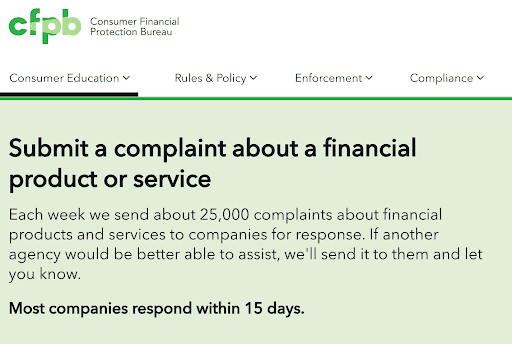
Dealing with student loans is frustrating, but it can be even more overwhelming if you’re facing a student loan dispute with your loan servicer. If you have an issue to report, here’s a guide on how to dispute student loans and what to do next if you need to escalate the matter.
Typical issues leading to dispute student loans
Student loan processing mistakes happen when student loan borrowers are in repayment. Some common reasons to dispute student loans include:
- Incorrect payment amounts.
- Missing student loan payments.
- Not being properly credited for payments (such as with PSLF).
- Payments marked as late, when they’re not.
- Payments that aren’t reported to the credit bureaus.
- Forgiven federal loans still showing a balance.
- Wrong recertification date on file.
- Inaccurate loan balance, especially after a refund.
If you’re facing any of these problems, take action to remedy the issue as soon as possible. It’s important to understand certain things that you can’t dispute — like your payment amount and getting a lower bill, or your interest rate.
However, you might be able to accomplish those requests with a new repayment option, like an Income-Driven Repayment (IDR) plan or through student loan refinancing.
Get Started With Our New IDR Calculator

Initial steps to resolve a dispute
To dispute student loan matters with your loan servicer, taking action quickly is key. If you’re having issues, here are the initial steps to resolve a student loan dispute.
Gather necessary documents
Typically, when you dispute student loans, there’s a conflict between you and the loan servicer about a particular detail. For example, maybe the monthly payment on your federal student loan is showing up as late when you have proof you’ve paid on time.
Late payments can negatively affect your credit score, which can impact the interest rates you get on other consumer loans. Plus, your credit history might be used for major clearances, like when applying for an apartment or a background check for a job.
Compile documents in advance that prove you’ve met your payment obligations on time and in full each month. For example, this might be a confirmation of payment from the servicer's site or bank statements showing the payment was processed before your due date.
If your student loan servicer hasn’t been reporting payments to the credit bureaus, provide your credit report. You can access your credit report using AnnualCreditReport.com, which has information from the three credit reporting agencies: Experian, TransUnion, and Equifax.
For borrowers working toward student loan forgiveness, your payment history may not be credited. In that case, provide supporting documentation. For example, if pursuing Public Service Loan Forgiveness (PSLF), provide your payment records and proof of eligible employment.
In the event that your federal loans have already been forgiven, but there’s still an outstanding balance, provide any letters or documentation from the U.S. Department of Education letting you know that your loans have been forgiven.
The goal is to provide any documentation that can support your case so you can fix any inaccuracies.
Contact your loan servicer or lender
After identifying the issue and gathering your documentation, contact your loan servicer or lender directly. To dispute student loans, get in touch with the entity that’s managing your student loan repayment.
For federal student loans, you can find your loan servicer information on your StudentAid.gov account. From your dashboard, select “My Loan Servicers.” Currently, there are five student loan servicers if your loans are in good standing and not in default:
- Edfinancial.
- MOHELA.
- Aidvantage.
- Nelnet.
- ECSI.
If your federal student loans are in default, your loan servicer is the Default Resolution Group.
You can also call 1-800-433-3243 to reach the Federal Student Aid Information Center to ask who your servicer is.
If you have private student loans, you can find the lender’s information on your credit report. Request your report from the major credit bureaus on AnnualCreditReport.com, or a service like Credit Karma.
After identifying your loan servicer or lender, visit their website to find a direct phone number and email address to contact a representative.
When communicating with a representative, make sure to write down their full name. Politely explain the reason for your concern and mention that you have supporting documentation. Ask for the next steps and how to provide your documents for their review.
Document the dispute
Document every interaction you have with the representative. This includes:
- Keeping all emails and electronic records.
- Taking notes of phone conversations, including time, date, and the person you spoke with. Also, any resolutions and turnaround times that are promised.
- If you send anything via mail, making copies and using certified mail.
- Including your student loan account number in your communications.
- Keeping track of timelines from when the problem started to resolution.
If you have to escalate your student loan dispute, having this kind of documentation can help you reach a resolution faster.
3 Ways to escalate the dispute resolution process
If your student loan dispute is unsuccessful, you might need to escalate your complaint to a higher authority.
1. Ask an ombudsman for a manual review
The Federal Student Aid (FSA) Ombudsman Group helps federal loan borrowers navigate unresolved complaints. As a neutral third party, the group can help you dispute student loans if there are still errors on your record.
You can submit a request for a manual review of your issue online or call 1-800-433-3243. If you have materials to send, you can fax them to 606-396-4821 or mail them to:
U.S. Department of Education
FSA Ombudsman Group
P.O. Box 1854
Monticello, KY 42633
See if your state has a student loan ombudsman or if your loan holder is on this list from The Institute of Student Loan Advisors (TISLA). Once you submit your request, an ombudsman will research your options and act as a liaison between you and all the parties involved.
2. File a complaint with the CFPB
As a next step, you can also file a complaint with the Consumer Financial Protection Bureau (CFPB) to dispute errors related to your student loans. The CFPB is a government agency that works on behalf of consumers, ensuring fair treatment by lenders and financial institutions.

To get started:
- Visit the CFPB complaint page.
- Scroll down and select “Start a new complaint.”
- Create a user account on CFPB, if you don’t have one.
- Submit a student loan complaint on CFPB, including the issue, attempts at resolution and supporting documentation.
- Wait for processing. You should get a response within 15 to 60 days.
- Review the company’s response. You’ll be notified when it’s available and can submit your feedback for up to 60 days.
3. Get help from a congressperson
If you still feel you’re getting nowhere, contact your local congressperson through what’s called “constituent services”. Through constituent services, a congressperson works on your behalf to help resolve your student loan grievance and provide referrals and information about your case.
To get started, go to your local official’s website to submit a request for assistance. For example, residents in Vermont can get help from Senator Bernie Sanders by filling out a request form. California residents can contact Senator Alex Padilla and submit a request online.
To find the official website, you can search for [your state + constituent services] or go to your Senator’s official government website.
Preventive measures and best practices for student loan disputes
No one wants to deal with a student loan dispute, as it can be time-consuming and frustrating. To help you avoid issues in the future:
- Create a student loan folder with all important documentation.
- Once a month, review your student loan account after your payment is made.
- Check for credit report errors a minimum of once a year or more.
- Sign up for text or email alerts.
- Update your mailing address, email, and phone number immediately if there are changes.
- Make copies of any forms you submit.
These preventative measures may help you avoid student loan disputes in the future and stay organized. Additionally, it’s important to know your rights and responsibilities as a student loan borrower.
Twelve states have passed a Student Loan Borrower Bill of Rights, with more states expected to follow. These protections aim to set standards, ban abusive practices and require transparency for student loan borrowers.
It’s also a good idea to review your Master Promissory Note, so you understand the terms and conditions of your student loans. This agreement outlines your legal responsibilities and can help you understand if your student loan dispute is valid or not.
Get help
Disputing student loans with your servicer can be a stressful and discouraging experience. Taking the steps above can help you try to get a resolution faster.
If you want even more support regarding your repayment strategy, in general, Student Loan Planner can help. We offer a custom student loan plan that outlines the next steps for you and your unique financial and life goals. Book a consultation today.
Not sure what to do with your student loans?
Take our 11 question quiz to get a personalized recommendation for 2024 on whether you should pursue PSLF, Biden’s New IDR plan, or refinancing (including the one lender we think could give you the best rate).
